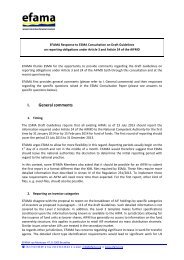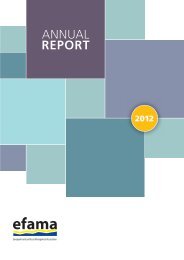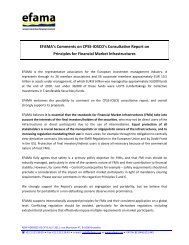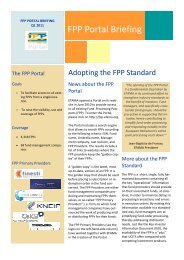EFAMA KPMG Solvency II Report
EFAMA KPMG Solvency II Report
EFAMA KPMG Solvency II Report
Create successful ePaper yourself
Turn your PDF publications into a flip-book with our unique Google optimized e-Paper software.
4.2 Data Management<br />
4.2.1 Data Delivery<br />
4 WORKING GROUP FINDINGS | 27<br />
Requirements<br />
<strong>Solvency</strong> <strong>II</strong> requires insurers to deliver their <strong>Solvency</strong> Calculations and their<br />
Quantitative <strong>Report</strong>ing Templates (QRT’s) within six weeks of each quarter end to their<br />
regulator. This is substantially earlier than required by current reporting regulations.<br />
Consistent data must be utilised for <strong>Solvency</strong> calculation and statutory reporting;<br />
hence insurers will require comprehensive, enriched details of the assets managed on<br />
their behalf for both Pillar 1 and Pillar 3 much earlier than currently provided.<br />
Given these timeframes and the significantly greater volume of data to be provided,<br />
asset managers are required to provide their insurance clients with more complex data<br />
at a more granular level and to a higher quality standard within a shorter timeframe.<br />
Challenges and Impacts<br />
Despite <strong>Solvency</strong> <strong>II</strong> requiring quarterly reporting to regulators, most insurers are<br />
intent on running their solvency calculations on a monthly basis to fulfil their Own Risk<br />
<strong>Solvency</strong> Assessment (ORSA) obligations under <strong>Solvency</strong> <strong>II</strong>. This will result in asset<br />
managers being required to supply insurers with the complete data information on a<br />
monthly basis.<br />
The trend, already visible in the market, is for <strong>Solvency</strong> <strong>II</strong> asset data to be requested<br />
for delivery by business day three each month. Meeting these delivery timelines will<br />
have significant impact on the operating model of asset managers and their third party<br />
administrators (TPAs) as the information currently available on business day three may<br />
not meet the rigorous granularity and quality standards for <strong>Solvency</strong> <strong>II</strong> data.<br />
In addition, the data required for <strong>Solvency</strong> <strong>II</strong> includes data relating to assets which<br />
are not traditionally valued until after month end (such as private equity, hard to price<br />
assets and collateral holdings) as well as funds which are not priced until the fi rst or<br />
second day of each month (such as multimanager funds or overseas asset funds).<br />
There are also likely to be issues regarding the consistency of data being provided<br />
by different suppliers.<br />
The lack of a uniform mechanism to transfer asset data between asset managers, TPAs<br />
and insurers is bound to lead to substantial development costs. Additionally, the lack<br />
of standard file formats and security infrastructure will increase the costs across all<br />
parties involved in the provision and receipt of asset data.<br />
The legal impacts of supplying confidential data between parties also need to be fully<br />
aligned. Parties need to ensure that all necessary legal agreements including nondisclosure<br />
agreements (NDAs), service level agreements (SLAs) and data licensing<br />
agreements with data vendors are in place prior to the commencement of test data<br />
transfer. These agreements may vary across the insurance industry and are an urgent<br />
issue which must be addressed in the very near future given the lead times of getting<br />
such agreements in place.<br />
© 2012 <strong>KPMG</strong> LLP, a UK limited liability partnership, is a subsidiary of <strong>KPMG</strong> Europe LLP and a member fi rm of the <strong>KPMG</strong> network of independent member fi rms affi liated with <strong>KPMG</strong> International<br />
Cooperative, a Swiss entity. All rights reserved.














